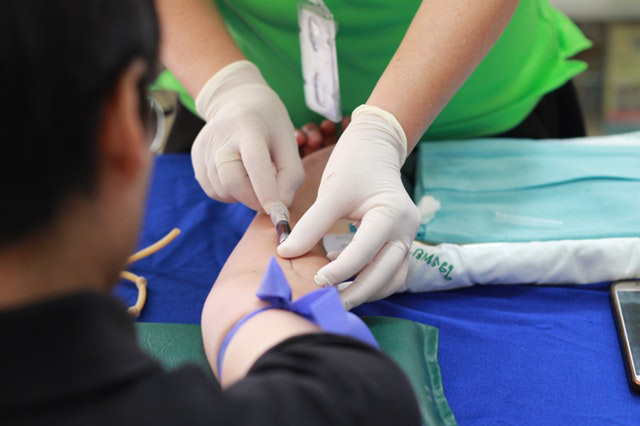Some Known Factual Statements About Northeast Medical Institute - New Haven Campus Phlebotomy Course & Cna Class
Some Known Factual Statements About Northeast Medical Institute - New Haven Campus Phlebotomy Course & Cna Class
Blog Article
The Ultimate Guide To Northeast Medical Institute - New Haven Campus Phlebotomy Course & Cna Class
Table of ContentsThe Ultimate Guide To Northeast Medical Institute - New Haven Campus Phlebotomy Course & Cna ClassThe Ultimate Guide To Northeast Medical Institute - New Haven Campus Phlebotomy Course & Cna ClassThe Best Strategy To Use For Northeast Medical Institute - New Haven Campus Phlebotomy Course & Cna ClassThe 8-Minute Rule for Northeast Medical Institute - New Haven Campus Phlebotomy Course & Cna ClassThe Main Principles Of Northeast Medical Institute - New Haven Campus Phlebotomy Course & Cna Class Some Ideas on Northeast Medical Institute - New Haven Campus Phlebotomy Course & Cna Class You Need To Know
The use of such devices should be come with by various other infection avoidance and control methods, and training in their use. Not all safety devices are appropriate to phlebotomy. Prior to selecting a safety-engineered device, customers must extensively investigate offered devices to establish their appropriate usage, compatibility with existing phlebotomy practices, and effectiveness in protecting staff and people (12, 33).For setups with reduced resources, expense is a motoring factor in procurement of safety-engineered tools. Where safety-engineered devices are not offered, proficient usage of a needle and syringe is appropriate.
In the blood-sampling area for an outpatient division or clinic, provide a comfy reclining couch with an arm remainder.
Northeast Medical Institute - New Haven Campus Phlebotomy Course & Cna Class Can Be Fun For Everyone
Guarantee that the indicators for blood sampling are clearly defined, either in a composed method or in recorded guidelines (e.g. in a research laboratory form). At all times, comply with the approaches for infection prevention and control detailed in Table 2.2. Infection avoidance and control methods. Gather all the equipment required for the treatment and place it within safe and very easy reach on a tray or trolley, ensuring that all the products are plainly noticeable.
Present yourself to the person, and ask the client to mention their complete name. Inspect that the research laboratory kind matches the person's identity (i.e. match the individual's details with the laboratory type, to make certain precise recognition).
Make the client comfortable in a supine setting (if feasible). Area a clean paper or towel under the individual's arm. Talk about the examination to be performed (see Annex F) and acquire verbal approval. The client has a right to decline a test at any time before the blood sampling, so it is essential to guarantee that the individual has actually comprehended the procedure.
Northeast Medical Institute - New Haven Campus Phlebotomy Course & Cna Class for Beginners
Prolong the individual's arm and evaluate the antecubital fossa or lower arm. Situate a blood vessel of a great dimension that is noticeable, straight and clear. The representation in Section 2.3, shows usual settings of the vessels, yet numerous variants are feasible. The average cubital capillary exists between muscles and is typically one of the most very easy to penetrate.
DO NOT put the needle where veins are drawing away, because this increases the possibility of a haematoma. Situating the vein will help in figuring out the correct dimension of needle.
Haemolysis, contamination and visibility of intravenous liquid and medicine can all change the results (39. Nursing team and physicians might access central venous lines for samplings adhering to procedures. Nevertheless, samplings from main lines lug a threat of contamination or erroneous laboratory test outcomes (https://www.4shared.com/u/c2pfSlvK/gordonmarvin28.html). It is acceptable, however not excellent, to draw blood samplings when first introducing an in-dwelling venous gadget, prior to attaching the cannula to the intravenous fluids.
5 Simple Techniques For Northeast Medical Institute - New Haven Campus Phlebotomy Course & Cna Class
Enable the area to completely dry. Failure to allow enough call time increases the danger of contamination. DO NOT touch the cleaned site; particularly, DO NOT position a finger over the blood vessel to direct the shaft of the exposed needle. It the site is touched, repeat the sanitation. Carry out venepuncture as complies with.
Ask the individual to form a hand so the blood vessels are extra noticeable. Go into the capillary quickly at a 30 degree angle or less, and remain to present the needle along the blood vessel at the easiest angle of access - CNA Classes. As soon as adequate blood has actually been collected, release the tourniquet BEFORE withdrawing the needle
Not known Facts About Northeast Medical Institute - New Haven Campus Phlebotomy Course & Cna Class
Take out the needle delicately and apply mild stress to the site with a tidy gauze or completely dry cotton-wool sphere. Ask the person to hold the gauze or cotton wool in area, with the arm prolonged and elevated. Ask the individual NOT to bend the arm, due to the fact that doing so creates a haematoma.

The Facts About Northeast Medical Institute - New Haven Campus Phlebotomy Course & Cna Class Revealed
Do not press the syringe bettor due to the fact that additional pressure increases the danger of haemolysis. Where feasible, maintain the tubes in a rack and move the rack towards you. Inject downwards into the suitable coloured stopper. DO NOT eliminate the stopper since it will certainly launch the vacuum cleaner. If the example tube does not have a rubber stopper, inject exceptionally gradually into the tube as decreasing the stress and rate made use of to move the sampling lowers the risk of haemolysis.

Report this page